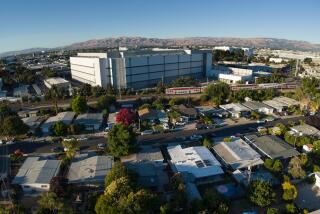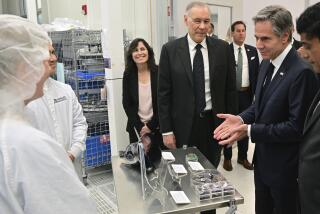CSUN Center Super-Sizes Its Computer
- Share via
NORTHRIDGE — Cal State Northridge has leased one of the San Fernando Valley’s first supercomputers, capable of processing immense amounts of data more rapidly than ever before. The new computer is being leased from Silicon Graphics for $300,000, one-quarter of its actual worth.
The supercomputer, with its 12 billion bytes of memory, is the centerpiece of CSUN’s new Northridge Computational Center, which has already formed a partnership with Lockheed Martin Skunk Works to pay half the lease and collaborate with CSUN students and faculty on projects.
Administrators at the center are also negotiating with film studios and plan to use the computer to teach students how to create digital films, special effects and learn other skills useful in the increasingly high-tech movie industry.
Center director Steven Fitzgerald said the supercomputer will be used by a variety of disciplines, including physics, math, engineering, arts, media and education.
Future engineering students in Professor Stewart Prince’s class plan to use the supercomputer to design and test a Formula One race car.
Previously, the class has had to create a physical model to test its aerodynamics in a wind tunnel. With the supercomputer, students will be able to conduct virtual aerodynamic tests.
“It’s just going to make things a lot easier,” student Starr Potter said.
“Anything you can do on a normal computer, the supercomputer will do faster, better, quicker, cleaner,” said Fitzgerald. A computation that would take a high-end personal computer days or weeks to perform--such as calculating weather patterns or earthquakes--takes only hours or minutes with the supercomputer.
Eventually, Fitzgerald said, he plans to hook up the machine to the Globus network, a grid of supercomputers at other institutions around the world that can work in concert to perform even more complex functions.
Once relegated to a small niche market of government agencies and large corporations, supercomputers are becoming increasingly common on college campuses and at other research institutions throughout the country. Along with companies like Hewlett-Packard and IBM, Silicon Graphics is attempting to install as many supercomputers on college campuses as possible.
“They want students to be trained on their supercomputer so that, when they go to work for a company, that’s the machine they ask for,” said Jim Moore, one of the center’s founders.
Company executives said one-third of all the supercomputers Silicon Graphics makes are bought by universities and colleges.
“Typically, universities are the most innovative users of our computers, and their discovery process is much different than a business,” said Chodi McReynolds, director of marketing for Mountain View, Calif.-based Silicon Graphics. “Universities are trying to map the human genome and cure cancer, they’re not just trying to push out a new product.”
Silicon Graphics is learning about its own product from its customers, McReynolds said.
Dan Dolan, a supercomputer industry analyst for the market research firm Dataquest, said supercomputer customers are diversifying as the machines become less expensive, as software becomes more advanced and as the hardware improves. The supercomputer market has shifted from the U.S. Departments of Defense and Energy to large private corporations and, most recently, public universities.
“It started with the scientific community doing thermonuclear and fluid simulations,” Dolan said. Now supercomputer customers range from manufacturing to insurance companies. And as the customer base for supercomputers increases--from 5,247 supercomputers in 1998 to a projected 8,275 in 2002--so does the need for trained supercomputer users, Dolan said.






